Working (out) from home
For millions these days, the abode doubles as an office. With virtual fitness, it’s a fully staffed gym too. By Haley Longman
G
uided at-home fitness programs are hardly new. Perhaps you remember a parent, years ago, sweating in the living room to a Jane Fonda or Richard Simmons tape. (Or maybe it was you.) Well, today group workouts can be done at home if you can’t make it to the gym or just don’t feel like leaving the house. Isn’t technology the best? Virtual fitness, the trend has been dubbed, although the aches and grunts are still real. It’s a fusion of exercise with technology in which gyms or workout studios stream fitness classes online or with an app, live or prerecorded, for participants to join at home in real time or as their schedule permits. The benefits are clear. Virtual fitness is ideal for those with busy schedules and sufferers from social anxiety who may be embarrassed not to know their Boot Camp from their Burn. The phenomenon is also gaining traction with clients who have memberships at brick-and-mortar gyms. “It provides a seamless experience,” Fitness Industry Technology Council President Brian O’Rourke told the International Health, Racquet and Sportsclub Association. “Members can do exactly the same classes they enjoy at the club. They have access to classes they wouldn’t be able to find [on the internet].” As “old-school” health clubs around the country like Gold’s Gym and Crunch create their own digital training apps for clientele who want the best of both worlds, others are taking it up a notch, launching virtual-only classes for customers who’d prefer to work out anywhere but a sweaty studio. But they’re not all just high-tech YouTube videos—the fitness world has seen a surge in live workout classes, all led by professional trainers. Obé (pronounced “obey”), launched in 2018 by two former Hollywood agents, offers 14 live workouts a day, taught by certified trainers out of a loft space in Brooklyn, punching and lunging in front of an illuminated neon backdrop. All you’ll need to participate is a laptop, WiFi and a yoga mat. A subscription to the app and website costs only $27 a month, which would barely cover the expense of a single one-hour class in a studio IRL. Then there’s ClassPassLive, which since its 2018 launch has allowed users to view live and on-demand HIIT (high-intensity interval training) classes. Here your metrics will display up on a leaderboard
SID.ss19.fitness.2.indd 61
with other participants’, as its unique ClassPass heartrate monitor tracks your stats and calorie burn. Yes, we suppose virtual motivation is part of what you get for this $15 per month subscription. New York City-based cycling studio Peloton was one of the first to venture into virtual fitness back in 2014; anyone who purchased a stationary Peloton bike could livestream their spin classes at home. The company more recently introduced its Tread, a glorified treadmill, which boasts 10 daily live running and cross-training classes, as well as pre-recorded ones. Its price tag? A cool $4,000, with an optional $39 per month for unlimited access to live classes. However, the new Peloton digital app is a bit more doable, offering 20 live classes per day remotely for $19.49 per month. “Our bike business is exploding in a good way,” says Peloton President William Lynch. The new Commercial S22i Studio Cycle is similar to the Peloton bike, yet this NordicTrack product lets cyclists have live interactions with their trainers, who can adjust their bikes’ incline, decline and resistance. There are also a variety of full-body workout classes available for when users need a respite from cycling, as well as a few other high-tech capabilities. All yours for $2,000. If you don’t want to stare at your phone while getting your fitness on and would rather just look, well, at yourself, that’s where the first-of-its-kind Mirror comes in. Once you press the power button, it transforms into a responsive display with stereo speakers, a camera, a microphone and, of course, a mirror. Watch one of its 50 live classes—there’s cardio, strength, yoga and boxing to choose from, as well as beginner or expert level—and you’ll see the instructor, yourself and your classmates on the LED screen. The Mirror itself costs $1,495, with a monthly content subscription of $39. Of course, today’s hot fad is tomorrow’s curio, but there’s every chance that virtual fitness will make a permanent place for itself. Obé founders Mark Mullett and Ashley Mills have waxed poetic about “the ability to get in a great sweat sesh, be held accountable via a shoutout from the instructor during a live class, and connect with a like-minded community beyond your immediate ZIP code—all from the comfort of home.” Oh, what a time to be alive. Now, come on, you can do this!
3/28/19 1:03 PM
